

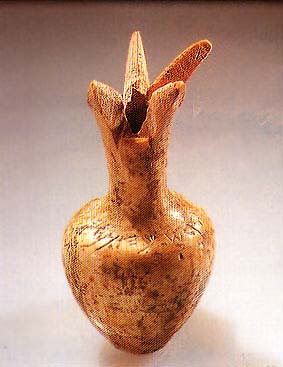 IVORY
POMEGRANATE
IVORY
POMEGRANATE
This thumb-sized pomegranate is believed to be the only known relic from
Solomon's Temple in Jerusalem. It probably served as the decorative head of a
ceremonial scepter used by the Temple priests during one of the ceremonies.
Around the shoulder of the pomegranate is a carefully incised inscription in early Hebrew characters, part of which is broken off, which reads: "qodes kohanim I-beyt [yahwe]h". "Sacred donation for the priests of (in) the House of [Yahwe]h." "House of Yahweh" most probably refers to the Temple in Jerusalem.
The juicy pomegranate fruit with its multitudinous seeds was a popular symbol of fertility and fecundity in acient times, and was widely used in the sacred and secular art of various cultures throughout the ancient Near East. The pomeranate is frequently mentioned in the Bible and is one of the seven fruits with which the Land of Israel is blessed (Deutoronomy 8:8). It was a favorite motif in the Temple of Solomon, and decorated the capitals of the two freestanding columns at the entrance to the Temple (1 Kings 7:21).
Jerusalem: An Inscribed Pomegranate from the Solomonic Temple
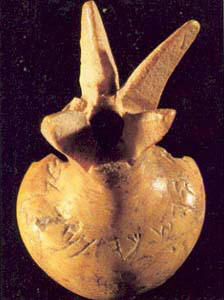 The Israel Museum recently acquired a thumb-sized ivory pomegranate, 43 mm.
high. Its body is vase-shaped and it has a long neck with six elongated petals.
The body is solid with a small, rather deep hole in the base, probably for the
insertion of a rod. Around the shoulder of the pomegranate is an incised
inscription in paleo-Hebrew script, part of which is missing. It was, however,
possible to reconstruct the missing word based on the surviving text and
biblical evidence. The inscription reads: sacred donation for the priests of
the house of [Yahwe]h.
The Israel Museum recently acquired a thumb-sized ivory pomegranate, 43 mm.
high. Its body is vase-shaped and it has a long neck with six elongated petals.
The body is solid with a small, rather deep hole in the base, probably for the
insertion of a rod. Around the shoulder of the pomegranate is an incised
inscription in paleo-Hebrew script, part of which is missing. It was, however,
possible to reconstruct the missing word based on the surviving text and
biblical evidence. The inscription reads: sacred donation for the priests of
the house of [Yahwe]h.
This pomegranate is the only known relic associated with the Temple built by King Solomon on Mt. Moriah in Jerusalem. According to its paleographic style, the inscription dates to the mid-8th century BCE. The small pomegranate was probably a gift to the Temple of Yahweh in Jerusalem – the only such temple in the Kingdom of Judah.
The pomegranate fruit (rimon in Hebrew), with its abundance of juicy seeds has been regarded as a symbol of fertility for thousands of years. It is frequently mentioned in the Bible and is one of the seven species with which the Land of Israel is blessed (Deuteronomy 8:8). It was also a favorite motif of Jewish art in ancient times: the capitals of two columns in the facade of the Temple in Jerusalem were decorated with pomegranates (1 Kings 7:42) and so were the robes of the High Priest. (Exodus 28: 33-34)
We may therefore assume that the rites performed by the priests in the Temple in Jerusalem included the use of scepters decorated with pomegranates, such as the one on view at the Israel Museum.
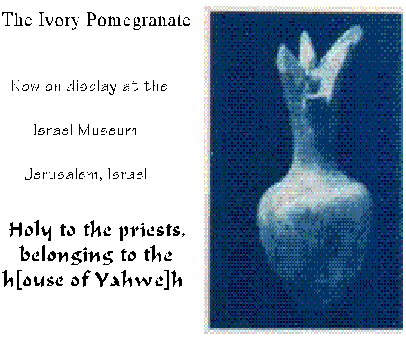
BEST OF POD
JUNE 13. 1999
The average person would think the field of Biblical Archaeology is based upon the Bible. Today most of the experts in this field have thrown away the Book. They have turned to terms like "Common Era" (CE), or "Before Common Era" (BCE) to replace the fundamentally held Biblical view of "After Death" (AD), or "Before Christ" (BC).
Today most Biblical events such as the Exodus are turned to myth by these new biblical archaeologists. All evidence they uncover must first pass through their philosophical sieve before it can be evaluated. To them, the Bible is a book of myths. This philosophy is what influenced the evaluation of the artifact now being discoursed. I believe the Bible overwhelmingly points to an almond bud scepter being used ceremonially by a priest in Solomon's Temple as opposed to a pomegranate bud scepter as they propose. Both an almond bud, and a pomegranate bud look the same before blooming.
The Creator God of the Bible claims absolute control of providence and circumstance. It is through providence and circumstance that only one artifact has surfaced from Solomon's Temple. Andre Lemaire while working at the Ecole Biblique in Jerusalem in 1979 found it at a local antique dealer. It gained prominence through an article he wrote for the Biblical Archaeology Review. It was smuggled out of Israel and put on display at the Grand Palais in Paris in 1988. It was promptly purchased by the Israel Museum in Jerusalem through an anonymous gift for $550,000.
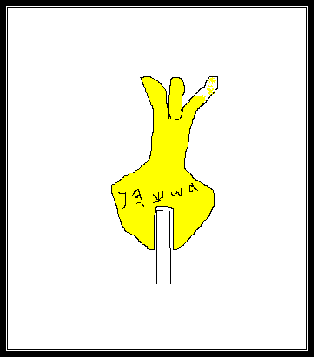 It
seems most probable that this is a scepter head. It is only
1.68 inches high, and .83 inches wide. It has a 6.5 mm hole drilled 15 mm deep
into it's bottom. This is where the shaft of the scepter was inserted.
It
seems most probable that this is a scepter head. It is only
1.68 inches high, and .83 inches wide. It has a 6.5 mm hole drilled 15 mm deep
into it's bottom. This is where the shaft of the scepter was inserted.
There is speculation that rather then a scepter head, this could be an ornamental cap to a piece of furniture. That is always a possibility, but I shall pursue the scepter idea.
Similar scepters, but non-Jewish, have been discovered in a priest's grave at Tel Nami South of Haifa, in a Canaanite Temple at Lachish, and at Achziv north of Haifa.
What ties this scepter head to Solomon's Temple is the almost complete inscription it bears in palo-Hebrew letters ( the [ ] bracket missing letters). "Qodes kohanim, I-b[eyt Yahwe]h," translated "Holy to the priests, belonging to the H[ouse of Yahwe]h." The palo graphic date of 765 -705 BC accepted by even the most skeptical would put it in the reign of Hezekiah 727 - 698 BC. He was noted for his reforms.
Another alternative translation, substituting "H[ouse of Asera]h" for the missing letters inside the brackets would be possible seeing it was the worship of pagan gods that the reforms were eliminating. I will again pursue this as a Jewish relic, not a pagan one. The house of Yahweh is a common Biblical term. It appears numerous times in the Bible (house of the LORD). A return to the Bible in Hezekiah's day would increase expectations of the use of Biblical phrases.
The argument for a pomegranate connected to the priests and the Temple (house of Yahweh) has some Biblical credence.
Numbers 16 tells of a great rebellion in the wilderness led by some of the Levites. God puts a quick end to this dispute by destroying the rebels. Even this demonstration did not stop the murmurings, so in Numbers 17 God clearly establishes His choice in the Spiritual leadership of Aaron as head of the Levites. The method was that each tribe would submit a rod (scepter) with their name inscribed. The rods (scepters) were to be placed in the tabernacle overnight.
Numbers 17:
5 And it shall come to pass, that the man's rod, whom I shall choose, shall blossom: and I will make to cease from me the murmurings of the children of Israel, whereby they murmur against you.
6 And Moses spake unto the children of Israel, and every one of their princes gave him a rod apiece, for each prince one, according to their fathers' houses, even twelve rods: and the rod of Aaron was among their rods.
7 And Moses laid up the rods before the LORD in the tabernacle of witness.
God was about to declare His choice for High Priest, and the High Priesthood's future linage. The linage which survived up to the time of Christ. Only with the murder of John Hyrcanus by Herod the Great did the Aaronic High Priesthood end, and a political High Priesthood take its' place. (Christ cleared the Temple twice of the moneychangers that represented the secularization of Temple Worship by these new High Priests).
Numbers 17:
8 And it came to pass, that on the morrow Moses went into the tabernacle of witness; and, behold, the rod of Aaron for the house of Levi was budded, and brought forth buds, and bloomed blossoms, and yielded almonds.
9 And Moses brought out all the rods from before the LORD unto all the children of Israel: and they looked, and took every man his rod.
10 And the LORD said unto Moses, Bring Aaron's rod again before the testimony, to be kept for a token against the rebels; and thou shalt quite take away their murmurings from me, that they die not.
Notice the bud was not that of a pomegranate, but that of an almond. If any future priest wanted to carry a scepter representing the priesthood as established by God through Aaron, his knowledge of the Bible, and the history of the priesthood would logically drive that choice more toward an almond budded scepter rather then a pomegranate. The phraseology of verse 10 "to be kept" may well indicate this was the point when that rod was put in the Ark of the covenant for the very purpose of being an eternal reminder to all Jewish rebels opposed to God's established spiritual authority.
Hebrews 9:4
Which had the golden censer, and the ark of the covenant overlaid round about with gold, wherein was the golden pot that had manna, and Aaron's rod that budded, and the tables of the covenant;
Aaron's rod had already established a Biblical reputation long before these events. Interesting on its own is the Hebrew word used for "rod" (mat-tah). The Strong's Concordance lists as one of the definitions of "mat-tah" is "scepter." The translators of the New International Version also saw the same meaning in "mat-tah" when they translated it as "scepter."
Jeremiah 48:17
Mourn for her, all who live around her, all who know her fame; say, how broken is the mighty scepter, how broken the glorious staff!
The first encounter with Aaron's rod comes with the Biblical events leading up to the Exodus. It was Aaron's rod that was cast down at Pharaoh's feet to start the whole saga of the Exodus?
Exodus 7:12
For they cast down every man his rod, and they became serpents: but Aaron's rod swallowed up their rods.
It was also Aaron's rod (scepter) that was used symbolically when God turned the Nile River into blood?
Exodus 7:
15 Get thee unto Pharaoh in the morning; lo, he goeth out unto the water; and thou shalt stand by the river's brink against he come; and the rod which was turned to a serpent shalt thou take in thine hand.
16 And thou shalt say unto him, The LORD God of the Hebrews hath sent me unto thee, saying, Let my people go, that they may serve me in the wilderness: and, behold, hitherto thou wouldest not hear.
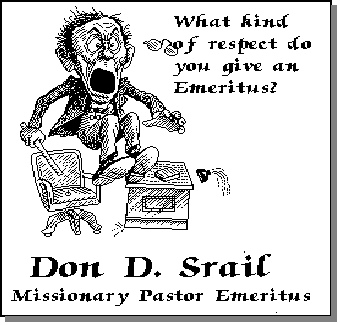 Again it was Aaron's rod that was used at Horeb when water was
brought forth from the rock.
Again it was Aaron's rod that was used at Horeb when water was
brought forth from the rock.
Exodus 17:
4 And Moses cried unto the LORD, saying, What shall I do unto this people? they be almost ready to stone me.
5 And the LORD said unto Moses, Go on before the people, and take with thee of the elders of Israel; and thy rod, wherewith thou smotest the river, take in thine hand, and go.
6 Behold, I will stand before thee there upon the rock in Horeb; and thou shalt smite the rock, and there shall come water out of it, that the people may drink. And Moses did so in the sight of the elders of Israel.
Now I realize that Aaron and Moses could have each had their own rod (scepter). It is possible that both were used to touch the Nile, and this latest use of a rod does not prove Aaron's rod was the one used. However, it was Aaron's rod that started the symbolic show of God's power over Egypt. It was not looked upon as just some stick he picked up by the wayside. Another important thing we know is that it was a rod from an almond tree, and not a pomegranate. When it budded, it budded almond buds not pomegranate buds.
There is no doubt that the power of the God of Israel proceeded their arrival in Canaan. It would make sense that the pagan priests who only knew the worldly mystical powers similar to that of Pharaoh's magicians would try to prepare a counter to what they thought was only more worldly mysticism. Not knowing they were coming up against the Omniscient Creator God, they might associate the miracles to the instruments rather then the true source of the power. The pomegranate scepters found among the pagan ruins near Haifa which I mentioned earlier might be mis-identified. They might be attempts to duplicate Aaron's rod that budded? They could well be symbolic almond headed scepters, rather then the look alike pomegranate scepters the anti-biblical archaeologists would want to believe. The pagans might have been trying to copy the methods of the God of Israel, rather then Israel trying to copy the pagans as they suggest? The pre Exodus dating of those scepters only indicates the fact that dating artifacts is not an exact science!
An almond bud at the end of a shaft is not something new to the house of Yahweh (Temple Worship). Another interesting Biblical fact is that the Golden Candlestick kept in the Temple had almond buds at the end of each of the seven shafts.
Exodus 37:
17 And he made the candlestick of pure gold: of beaten work made he the candlestick; his shaft, and his branch, his bowls, his knops, and his flowers, were of the same:
18 And six branches going out of the sides thereof; three branches of the candlestick out of the one side thereof, and three branches of the candlestick out of the other side thereof:
19 Three bowls made after the fashion of almonds in one branch, a knop and a flower; and three bowls made like almonds in another branch, a knop and a flower: so throughout the six branches going out of the candlestick.
20 And in the candlestick were four bowls made like almonds, his knops, and his flowers:
21 And a knop under two branches of the same, and a knop under two branches of the same, and a knop under two branches of the same, according to the six branches going out of it.
22 Their knops and their branches were of the same: all of it was one beaten work of pure gold.
This in itself is not much of an argument, but it does indicate that there is as much room for seeing an almond bud due to peripheral Temple usage as there is for a pomegranate. The pomegranate of course is the more politically correct view. An almond bud directly pointing to the Aaronic priesthood , and the events of the Exodus falls through the sieve of the secular Biblical Archaeologist before it could ever be contemplated. I doubt that any bending toward an Almond bud will ever take place so long as there is breath left in a single anthropologist now dominating the field of anti-Biblical Archaeology. It is only those who love the Word that I offer this possible view of the only artifact from Solomon's Temple.
Do I see something significant in why this of all objects should the God of providence and circumstance reveal to this generation? You bet-cha! It was the prophet Jeremiah who saw the prophetically miraculous resurgence of the Aaronic Priesthood coming. It was necessary before the Second Jewish Temple was built, and will be necessary before the Third Jewish Temple is built. At a future day, God will re-establish the Aaronic High Priesthood as miraculously as He caused Aaron's rod to bud. The Third Jewish Temple is a fact of Biblical prophecy. For any Jewish Temple to function, it will need an Aaronic High Priest. Jeremiah saw that day twice taking place before the final High Priest will establish Himself as the eternal, never ending High Priest (Jesus Christ as the eternal Melchizedek High Priest)! On that day the city of Salem will again have a Melchizedek High Priest, but one who will rule Old Salem, the New Jerusalem forever.
Jeremiah 1:
9 Then the LORD put forth his hand, and touched my mouth. And the LORD said unto me, Behold, I have put my words in thy mouth.
10 See, I have this day set thee over the nations and over the kingdoms, to root out, and to pull down, and to destroy, and to throw down, to build, and to plant.
11 Moreover the word of the LORD came unto me, saying, Jeremiah, what seest thou? And I said, I see a rod of an almond tree.
12 Then said the LORD unto me, Thou hast well seen: for I will hasten my word to perform it.
Will this prophecy of Jeremiah have another fulfilment in our day?
What seest thou? Do you possess the same vision as Jeremiah? What do you see when you look at this so called ivory pomegranate?
How will God preform this great restoration?
There is no written record of a scepter being used in the Temple.
One of the seven feasts recorded in the Bible is the Feast of Tabernacles. A possible use of the almond headed scepter in Temple Worship Service would be when the priests went to the pool of Siloam. This was in remembrance of how God supplied water from the rock during their wilderness journey. It was Aaron's rod with which Moses struck the rock. What better symbol of this provision then a scepter representing Aaron's rod? There is no record of a scepter being used in Temple Worship, but we do have a scepter head found in Jerusalem. Edersheim gives some insight into the ceremony in "The Temple." He refers to the Feast of Tabernacles where he teaches:
"While the morning sacrifice was being prepared, a priest accompanied by a joyous procession with music, went down to the pool of Siloam, whence he drew water into a golden pitcher, capable of holding three log (rather more than two pints). But on the Sabbaths they fetched the water from a golden vessel in the Temple itself, into which it had been carried from Siloam on the preceding day. At the same time that the procession started for Siloam, another went to a place in the Kidron Valley, close by, called Motza, whence they brought willow branches, which amid the blasts of the priests' trumpets, they stuck on either side of the altar of burnt offering, bending them over towards it, so as to form a kind of leafy canopy. Then the ordinary sacrifice proceeded, the priest who had gone to Siloam so timed it, that he returned just as his brethren carried up the pieces of the sacrifice to lay them on the altar. As he entered by the Watergate, which obtained its name from this ceremony, he was received by a three fold blast from the priests trumpets. The priest then went up the rise of the altar and turned to the left, where there were two silver basins with narrow holes - the eastern a little wider for the wine, and the western somewhat narrower for the water. Into these the wine of the drink offering was poured, and at the same time the water from Siloam, the people shouted to the priest, "Raise thy hand," to show that he really poured the water into the basin, which led to the base of the altar. For sharing the objections of the Sadducees, Alexander Jannaeus, the Maccabe an king-priest (about 95 BC), had shown his contempt for the Pharisees by pouring the water at this feast on the ground, on which the people pelted him with their aethrogs, and would have murdered him, if his foreign body-guard had not interfered, on which occasion no less than six thousand Jews were killed in the Temple."

Everything in the Temple had to be kosher. Even the slightest deviation (like that of Alexander Jannaeus) from perfection would not be tolerated. Who could have the authority to re-establish a kosher Temple but one who has direct contact with God?
It's a shame that the Pat Robertson's of our day trivialize true Biblical revelation in their made for TV visions of a "word of knowledge." Many will scoff at the Two Witnesses because Biblical Revelation will have been trivialized by the Charismatic movement of today. Woe to the money changers of today that go about God's business for profit and gain, lightly estimating this awesome God of the Bible who may be about to renew His relationship with Israel.
The Neo-evangelicals and Charismatics have systematically destroyed 2000 years of Church testimony centered in Biblical doctrine. If a fundamentalist stands up for doctrine today, he is maligned as committing sin and disrupting unity in this era of Church history. I believe God may be ready to spue modern indifferent Christianity from His mouth. A new relationship between God and man may be about to start centered around the Third Jewish Temple?
It was at the Feast of Tabernacles as described by Edersheim that Jesus taught the great truth about doctrine. Groups like the Gideon's brand doctrine as troublesome to unification. Many high profile Christian leaders, denominations, and organizations condone this same philosophy. In John 7, Jesus Christ attends the Feast of Tabernacles incognito as it were, but forcefully exposes Himself when the crowd shouted to the secular High Priest (Caiaphas - see: "Apology from the Tomb" - below) "Raise Thy Hand."
John 7:
10 But when his brethren were gone up, then went he also up unto the feast,(Feast of Tabernacles) not openly, but as it were in secret.
11 Then the Jews sought him at the feast, and said, Where is he?
12 And there was much murmuring among the people concerning him: for some said, He is a good man: others said, Nay; but he deceiveth the people.
13 Howbeit no man spake openly of him for fear of the Jews.
14 Now about the midst of the feast Jesus went up into the temple, and taught.
15 And the Jews marvelled, saying, How knoweth this man letters, having never learned?
16 Jesus answered them, and said, My doctrine is not mine, but his that sent me.
17 If any man will do his will, he shall know of the doctrine, whether it be of God, or whether I speak of myself.
18 He that speaketh of himself seeketh his own glory: but he that seeketh his glory that sent him, the same is true, and no unrighteousness is in him.
The doctrine of Jesus "My doctrine" was meant to separate and divide Him from what the secular Jewish religion had become. It was back to the Bible doctrine that always separates the spiritual from the carnal.
It was also on this same occasion, just a few verses farther, and most probable at the very moment when the crowd cried out to the High Priest after he poured the water on the Altar "Raise thy hand," that Jesus Himself cried out!
John 7:
37 In the last day, that great day of the feast (Feast of Tabernacles when the procession from the pool of siloam took place), Jesus stood and cried, saying, If any man thirst, let him come unto me, and drink.
38 He that believeth on me, as the scripture hath said, out of his belly shall flow rivers of living water.
39 (But this spake he of the Spirit, which they that believe on him should receive: for the Holy Ghost was not yet given; because that Jesus was not yet glorified.)
40 Many of the people therefore, when they heard this saying, said, Of a truth this is the Prophet.
41 Others said, This is the Christ. But some said, Shall Christ come out of Galilee?
42 Hath not the scripture said, That Christ cometh of the seed of David, and out of the town of Bethlehem, where David was?
43 So there was a division among the people because of him.
There will always be division until Christ establishes His kingdom. We are one day closer to that great and glorious era. Biblical doctrine dictates the certainty of these events. The Lord Jesus Christ will come a second time to sit on His throne in the Third Jewish Temple! The revived Aaronic Priesthood must minister in preperation for the Second Coming of the Lord Jesus Christ when He assumes the High Priest position as represented by the final priesthood of Melchizedek. It is then that the Aaronic Priesthood will step aside for the eternal, everlasting Melchizedek priesthood of Christ. He will also be the Jewish King and Prophet. Jeremiah's vision of an almond rod representing the revived Aaronic Priesthood will find its second fulfillment at the beginning of the prophetic seven year Great Tribulation before the Second Coming of Christ when the Third Jewish Temple will be established in preperation for His return. This is prophetic reality!
Who is this Christ to you? Just another man trying to gain prominence, or is He truly the Christ promised from the beginning who was coming not for the righteous, but that sinners might be saved. My friend, if you are a sinner, then it is to this Christ that you need go! Cast yourself before Him, and you will find a friend who loves you to the point of dying in your place. Drink of the great Gospel doctrines found in the Bible. Learn of Him!
Last update January 19, 1997
Read about the bones of a Biblical High Priest found in the literal shadow of the Temple Mount!
See article: Apology from the Tomb
Read about Ezekiel's prophecy that opens the door to establishing the Coming Jewish Temple!
See article: The Last Jihad
Back to Table of Contents.